Our first night under canvas is spent in Kakum national park and it is very hot and uncomfortable. It is also very noisy as tree dassies and cicadas serenade back and forth. I go to bed, somewhat optimistically, in thermal PJs and crawl into a three-season sleeping bag. Sod’s law that West Africa is the fourth season – the too hot to need a damn sleeping bag season! Our day even begins an hour earlier than everyone else as I mistakenly set the alarm for 4:45 am, by which time I’m lying on my sleeping bag in my birthday suit (conservative Christi refused to strip off in case you’re wondering). We have a powerful yearning for air-conditioning!
Kakum national park is 145 square miles of tropical rainforest. It is famous for its jungle canopy walk, which of course is best done as the dawn creeps over the forest because first it’s not hot yet (a relative term) and second the wildlife will be taking advantage of the conditions to feed, frolic and enjoy themselves before the serious business of surviving another day in Africa begins. The canopy walk involves negotiating a series of rickety-looking, highly mobile bridges. Think Indiana Jones and the Temple of Doom. The question I ask is who has the right of way if some lumbering tree dweller prefers the man-made thoroughfare over swinging through the jungle as nature intended? We never need to answer that question, though, because the noise created by 18 noisy tourists scares away all the wildlife, including the elusive West African elephant, giant bongo antelopes, and bush babies (small nocturnal primates). At dawn the jungle is literally steaming, which is playing havoc with my camera again (Remember the Esteros del Ibera in Argentina?).
Back at the truck we eat a quick breakfast, pack up the tents, store the damn bags (I’m hating this part already) and then it’s back to the coast to visit another slave castle, which is known as either St. George’s or Elmina castle. During the drive we see a quite amazing series of shops in what can only be described as the African religious aesthetic. They include the Blood of Jesus bicycle shop, the Glory to God barbers, the Holy Ghost entertainment center, and the Kingdom of Heaven book store. Also there are endless posters celebrating the visit of President Obama in July 2009.
Elmina castle was originally build by the Portuguese in 1482 and is the oldest European building in sub-Saharan Africa. Christopher Columbus visited this castle in the same year it was built – some 10 years before discovering the New World. Obviously at this point slaves were only used in Europe. The castle was originally built to house gold, ivory, and spices, but these same storerooms became the holding cells for 600 men and 400 women. Kofi, our guide gives an excellent account of the awful life lead by these slaves during this time. It is believed that over a 20-year period as many as 15 million West Africans became embroiled in the slave trade. Outside the castle is the dynamic, edgy, dirty, poverty-stricken fishing port of Elmina. We explore a little, but it does not feel entirely safe – my camera is an unwelcome intruder – although we do see a new wooden fishing boat being build by hand.
Our busy day is not yet over as we drive a little further up the cost to the palm-fringed, idyllic Brenu beach. It’s Playa el Agua without the crowds. Christi and I enjoy a refreshing dip in the warm waters of the Atlantic, our tent pitched a mere 30 feet from the crashing waves among the palm trees. Now this is heavenly.
Blog post by Roderick Phillips, author of Weary Heart – a gut-wrenching tale of broken hearts and broken test tubes.



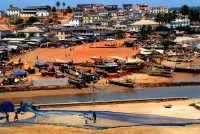
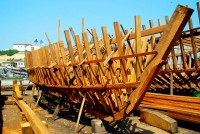
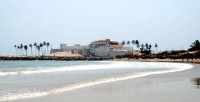
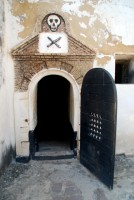

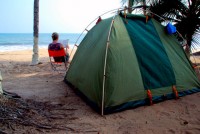
Speak Your Mind